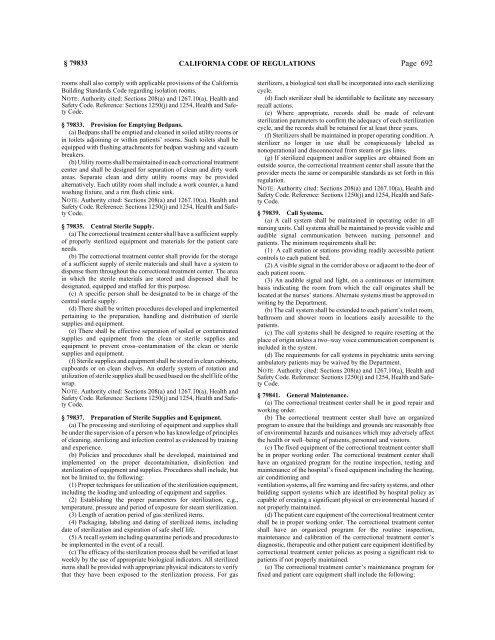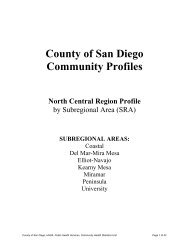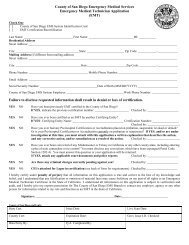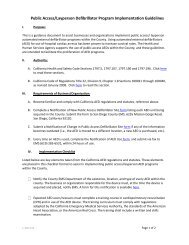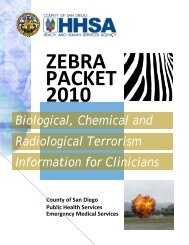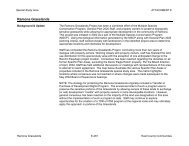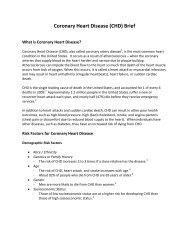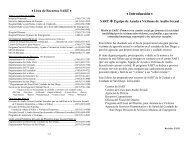CALIFORNIA CODE OF REGULATIONS - State of California
CALIFORNIA CODE OF REGULATIONS - State of California
CALIFORNIA CODE OF REGULATIONS - State of California
You also want an ePaper? Increase the reach of your titles
YUMPU automatically turns print PDFs into web optimized ePapers that Google loves.
§ 79833 <strong>CALIFORNIA</strong> <strong>CODE</strong> <strong>OF</strong> <strong>REGULATIONS</strong><br />
Page 692<br />
rooms shall also comply with applicable provisions <strong>of</strong> the <strong>California</strong><br />
Building Standards Code regarding isolation rooms.<br />
NOTE: Authority cited: Sections 208(a) and 1267.10(a), Health and<br />
Safety Code. Reference: Sections 1250(j) and 1254, Health and Safety<br />
Code.<br />
§ 79833. Provision for Emptying Bedpans.<br />
(a) Bedpans shall be emptied and cleaned in soiled utility rooms or<br />
in toilets adjoining or within patients’ rooms. Such toilets shall be<br />
equipped with flushing attachments for bedpan washing and vacuum<br />
breakers.<br />
(b) Utility rooms shall be maintained in each correctional treatment<br />
center and shall be designed for separation <strong>of</strong> clean and dirty work<br />
areas. Separate clean and dirty utility rooms may be provided<br />
alternatively. Each utility room shall include a work counter, a hand<br />
washing fixture, and a rim flush clinic sink.<br />
NOTE: Authority cited: Sections 208(a) and 1267.10(a), Health and<br />
Safety Code. Reference: Sections 1250(j) and 1254, Health and Safety<br />
Code.<br />
§ 79835. Central Sterile Supply.<br />
(a) The correctional treatment center shall have a sufficient supply<br />
<strong>of</strong> properly sterilized equipment and materials for the patient care<br />
needs.<br />
(b) The correctional treatment center shall provide for the storage<br />
<strong>of</strong> a sufficient supply <strong>of</strong> sterile materials and shall have a system to<br />
dispense them throughout the correctional treatment center. The area<br />
in which the sterile materials are stored and dispensed shall be<br />
designated, equipped and staffed for this purpose.<br />
(c) A specific person shall be designated to be in charge <strong>of</strong> the<br />
central sterile supply.<br />
(d) There shall be written procedures developed and implemented<br />
pertaining to the preparation, handling and distribution <strong>of</strong> sterile<br />
supplies and equipment.<br />
(e) There shall be effective separation <strong>of</strong> soiled or contaminated<br />
supplies and equipment from the clean or sterile supplies and<br />
equipment to prevent cross–contamination <strong>of</strong> the clean or sterile<br />
supplies and equipment.<br />
(f) Sterile supplies and equipment shall be stored in clean cabinets,<br />
cupboards or on clean shelves. An orderly system <strong>of</strong> rotation and<br />
utilization <strong>of</strong> sterile supplies shall be used based on the shelf life <strong>of</strong> the<br />
wrap.<br />
NOTE: Authority cited: Sections 208(a) and 1267.10(a), Health and<br />
Safety Code. Reference: Sections 1250(j) and 1254, Health and Safety<br />
Code.<br />
§ 79837. Preparation <strong>of</strong> Sterile Supplies and Equipment.<br />
(a) The processing and sterilizing <strong>of</strong> equipment and supplies shall<br />
be under the supervision <strong>of</strong> a person who has knowledge <strong>of</strong> principles<br />
<strong>of</strong> cleaning, sterilizing and infection control as evidenced by training<br />
and experience.<br />
(b) Policies and procedures shall be developed, maintained and<br />
implemented on the proper decontamination, disinfection and<br />
sterilization <strong>of</strong> equipment and supplies. Procedures shall include, but<br />
not be limited to, the following:<br />
(1) Proper techniques for utilization <strong>of</strong> the sterilization equipment,<br />
including the loading and unloading <strong>of</strong> equipment and supplies.<br />
(2) Establishing the proper parameters for sterilization, e.g.,<br />
temperature, pressure and period <strong>of</strong> exposure for steam sterilization.<br />
(3) Length <strong>of</strong> aeration period <strong>of</strong> gas sterilized items.<br />
(4) Packaging, labeling and dating <strong>of</strong> sterilized items, including<br />
date <strong>of</strong> sterilization and expiration <strong>of</strong> safe shelf life.<br />
(5) A recall system including quarantine periods and procedures to<br />
be implemented in the event <strong>of</strong> a recall.<br />
(c) The efficacy <strong>of</strong> the sterilization process shall be verified at least<br />
weekly by the use <strong>of</strong> appropriate biological indicators. All sterilized<br />
items shall be provided with appropriate physical indicators to verify<br />
that they have been exposed to the sterilization process. For gas<br />
sterilizers, a biological test shall be incorporated into each sterilizing<br />
cycle.<br />
(d) Each sterilizer shall be identifiable to facilitate any necessary<br />
recall actions.<br />
(e) Where appropriate, records shall be made <strong>of</strong> relevant<br />
sterilization parameters to confirm the adequacy <strong>of</strong> each sterilization<br />
cycle, and the records shall be retained for at least three years.<br />
(f) Sterilizers shall be maintained in proper operating condition. A<br />
sterilizer no longer in use shall be conspicuously labeled as<br />
nonoperational and disconnected from steam or gas lines.<br />
(g) If sterilized equipment and/or supplies are obtained from an<br />
outside source, the correctional treatment center shall assure that the<br />
provider meets the same or comparable standards as set forth in this<br />
regulation.<br />
NOTE: Authority cited: Sections 208(a) and 1267.10(a), Health and<br />
Safety Code. Reference: Sections 1250(j) and 1254, Health and Safety<br />
Code.<br />
§ 79839. Call Systems.<br />
(a) A call system shall be maintained in operating order in all<br />
nursing units. Call systems shall be maintained to provide visible and<br />
audible signal communication between nursing personnel and<br />
patients. The minimum requirements shall be:<br />
(1) A call station or stations providing readily accessible patient<br />
controls to each patient bed.<br />
(2) A visible signal in the corridor above or adjacent to the door <strong>of</strong><br />
each patient room.<br />
(3) An audible signal and light, on a continuous or intermittent<br />
basis indicating the room from which the call originates shall be<br />
located at the nurses’ stations. Alternate systems must be approved in<br />
writing by the Department.<br />
(b) The call system shall be extended to each patient’s toilet room,<br />
bathroom and shower room in locations easily accessible to the<br />
patients.<br />
(c) The call systems shall be designed to require resetting at the<br />
place <strong>of</strong> origin unless a two–way voice communication component is<br />
included in the system.<br />
(d) The requirements for call systems in psychiatric units serving<br />
ambulatory patients may be waived by the Department.<br />
NOTE: Authority cited: Sections 208(a) and 1267.10(a), Health and<br />
Safety Code. Reference: Sections 1250(j) and 1254, Health and Safety<br />
Code.<br />
§ 79841. General Maintenance.<br />
(a) The correctional treatment center shall be in good repair and<br />
working order.<br />
(b) The correctional treatment center shall have an organized<br />
program to ensure that the buildings and grounds are reasonably free<br />
<strong>of</strong> environmental hazards and nuisances which may adversely affect<br />
the health or well–being <strong>of</strong> patients, personnel and visitors.<br />
(c) The fixed equipment <strong>of</strong> the correctional treatment center shall<br />
be in proper working order. The correctional treatment center shall<br />
have an organized program for the routine inspection, testing and<br />
maintenance <strong>of</strong> the hospital’s fixed equipment including the heating,<br />
air conditioning and<br />
ventilation systems, all fire warning and fire safety systems, and other<br />
building support systems which are identified by hospital policy as<br />
capable <strong>of</strong> creating a significant physical or environmental hazard if<br />
not properly maintained.<br />
(d) The patient care equipment <strong>of</strong> the correctional treatment center<br />
shall be in proper working order. The correctional treatment center<br />
shall have an organized program for the routine inspection,<br />
maintenance and calibration <strong>of</strong> the correctional treatment center’s<br />
diagnostic, therapeutic and other patient care equipment identified by<br />
correctional treatment center policies as posing a significant risk to<br />
patients if not properly maintained.<br />
(e) The correctional treatment center’s maintenance program for<br />
fixed and patient care equipment shall include the following:


